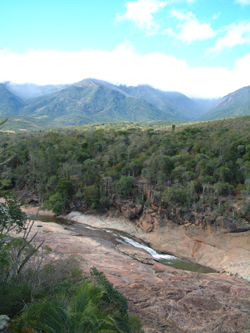|
Baly Bay
Baie de Baly National Park is a National Park in Madagascar. Geography Baie de Baly National Park or Baly Bay National Park is situated in the region of Boeny, District of Soalala, close to Soalala and Ambohipaky, approximately to the next major city Mahajanga. The Tsingy de Namoroka National Park borders this park. Vegetation consist of dry deciduous forests, scrub-shrub or bamboo shrub, mangroves, lakes and swamps mixed with savanna. Its southern border is formed by the Kapiloza River and the Andranomavo River crosses the park. It is bordered in the north by the Mozambique Channel and in the east by the Bay of Marambitsy. Flora and fauna The Baie de Baly National Park is the only known natural habitat of the critically endangered Angonoka tortoise or ploughshare tortoise (''Astrochelys yniphora''). Other rare animals found in this park is the Madagascan sideneck turtle (''Erymnochelys madagascariensis''), as well as the dugong, a marine mammal and the Madagascar fish ... [...More Info...] [...Related Items...] OR: [Wikipedia] [Google] [Baidu] |
Sakaraha
Sakaraha is a town and municipality in Atsimo-Andrefana Region, south-western Madagascar. It has a population of 31,183 in 2018. Geography Sakaraha is situated along route nationale No. 7 (Tuléar- Fianarantsoa) at 134 km from Tuléar, 64 km from Andranovory and 84 km from Ilakaka. It is situated at the Zombitse-Vohibasia National Park. Economy Mining: there are sapphires found in the town of Sakaraha. Natural gas was discovered near Sakaraha by Madagascar Southern Petroleum Company (MSCP) in 2011. There are also some oil deposits near Sakaraha but there is no commercial exploration. On 31 January 2007, Saudi terrorist Mohammed Jamal Khalifa Mohammed Jamal Khalifa ( ar, محمد جمال خليفه) (1 February 1957 – 31 January 2007) was a Saudi businessman from Jeddah who married one of Osama bin Laden's sisters. He has been accused of funding terror plots and groups in the P ... was murdered by 25 to 30 armed men while visiting a gemstone mine he own ... [...More Info...] [...Related Items...] OR: [Wikipedia] [Google] [Baidu] |
Dugong
The dugong (; ''Dugong dugon'') is a marine mammal. It is one of four living species of the order Sirenia, which also includes three species of manatees. It is the only living representative of the once-diverse family Dugongidae; its closest modern relative, Steller's sea cow (''Hydrodamalis gigas''), was hunted to extinction in the 18th century. The dugong is the only sirenian in its range, which spans the waters of some 40 countries and territories throughout the Indo-West Pacific. The dugong is largely dependent on seagrass communities for subsistence and is thus restricted to the coastal habitats which support seagrass meadows, with the largest dugong concentrations typically occurring in wide, shallow, protected areas such as bays, mangrove channels, the waters of large inshore islands and inter-reefal waters. The northern waters of Australia between Shark Bay and Moreton Bay are believed to be the dugong's contemporary stronghold. Like all modern sirenians, the dugong ... [...More Info...] [...Related Items...] OR: [Wikipedia] [Google] [Baidu] |
Bays Of Madagascar
A bay is a recessed, coastal body of water that directly connects to a larger main body of water, such as an ocean, a lake, or another bay. A large bay is usually called a gulf, sea, sound, or bight. A cove is a small, circular bay with a narrow entrance. A fjord is an elongated bay formed by glacial action. A bay can be the estuary of a river, such as the Chesapeake Bay, an estuary of the Susquehanna River. Bays may also be nested within each other; for example, James Bay is an arm of Hudson Bay in northeastern Canada. Some large bays, such as the Bay of Bengal and Hudson Bay, have varied marine geology. The land surrounding a bay often reduces the strength of winds and blocks waves. Bays may have as wide a variety of shoreline characteristics as other shorelines. In some cases, bays have beaches, which "are usually characterized by a steep upper foreshore with a broad, flat fronting terrace".Maurice Schwartz, ''Encyclopedia of Coastal Science'' (2006), p. 129. Bays were sig ... [...More Info...] [...Related Items...] OR: [Wikipedia] [Google] [Baidu] |
1997 Establishments In Madagascar
File:1997 Events Collage.png, From left, clockwise: The movie set of ''Titanic (1997 film), Titanic'', the List of highest-grossing films, highest-grossing movie in history at the time; ''Harry Potter and the Philosopher's Stone'', is published; Comet Hale-Bopp passes by Earth and becomes one of the most observed comet, comets of the 20th century; Golden Bauhinia Square, where sovereignty of Hong Kong is Handover of Hong Kong, handed over from the United Kingdom to the People's Republic of China; the 1997 Central European flood kills 114 people in the Czech Republic, Poland, and Germany; Korean Air Flight 801 crashes during heavy rain on Guam, killing 229; Mars Pathfinder and Sojourner (rover), Sojourner land on Mars; flowers left outside Kensington Palace following the death of Diana, Princess of Wales, in a car crash in Paris., 300x300px, thumb rect 0 0 200 200 Titanic (1997 film) rect 200 0 400 200 Harry Potter rect 400 0 600 200 Comet Hale-Bopp rect 0 200 300 400 Death of Diana ... [...More Info...] [...Related Items...] OR: [Wikipedia] [Google] [Baidu] |
Fauna Of Madagascar
The fauna of Madagascar is a part of the wildlife of Madagascar. Madagascar has been an isolated island for about 70 million years, breaking away from Africa around 165 million years ago, then from India nearly 100 million years later. This isolation led to the development of a unique endemic fauna. Before humans arrived about 2,000 years ago, there were many large and unusual animals living there, descended from species that were originally present when Madagascar became an island, or from species that later crossed the sea to Madagascar. Ecological niches were often filled by animals with quite different histories from those on the African mainland, often leading to convergent evolution. A large proportion of these endemic Malagasy animals have died out since the arrival of humans, most particularly the megafauna. Despite this, and massive deforestation, Madagascar is still home to an incredible array of wildlife, the vast majority of which is unique in the world. Madaga ... [...More Info...] [...Related Items...] OR: [Wikipedia] [Google] [Baidu] |
List Of National Parks Of Madagascar
This list of national parks of Madagascar includes all officially recognized protected areas as of 2015. The protected areas network of Madagascar is managed by the Madagascar National Parks Association (PNM-ANGAP). The network includes three types of protected areas: Strict Nature Reserves (IUCN category Ia), National Parks (IUCN category II) and Wildlife Reserves (IUCN category IV). At the 2003 IUCN World Parks Congress in Durban, the Malagasy President, Marc Ravalomanana, announced an initiative to more than triple the area under protection from approximately to over (from 3% to 10% of Madagascar's area). This "Durban Vision", as it has been dubbed, involved broadening the definition of protected areas in the country and legislation has been passed to allow the creation of four new categories of protected area: Natural Parks (IUCN category II), Natural Monuments (IUCN category III), Protected Landscapes (IUCN category V), and Natural Resource Reserves (IUCN category VI). As w ... [...More Info...] [...Related Items...] OR: [Wikipedia] [Google] [Baidu] |
Erythrophleum Couminga
''Erythrophleum couminga'' is a species of leguminous tree in the genus '' Erythrophleum''. It is endemic to the western coastal region of Madagascar, occurring in the Baie de Baly National Park. The bark is used in traditional medicine and the branches are used for fencing posts. Description ''Erythrophleum couminga'' is a moderate-sized deciduous tree which grows to a height of up to . The trunk has rough, fissured bark and the twigs are downy when young. The leaves are compoundly bipinnate with two to four pairs of pinnae. Each pinna has a petiole, a rachis up to long, and eight to twelve alternate leaflets with rounded bases and acute apexes. The inflorescence is a loose panicle A panicle is a much-branched inflorescence. (softcover ). Some authors distinguish it from a compound spike inflorescence, by requiring that the flowers (and fruit) be pedicellate (having a single stem per flower). The branches of a panicle are of ... growing in a leaf axil. The individu ... [...More Info...] [...Related Items...] OR: [Wikipedia] [Google] [Baidu] |
Perrierbambus
''Perrierbambus'' is a genus of Madagascan bamboo in the grass family. The genus name of ''Perrierbambus'' is in honour of Joseph Marie Henry Alfred Perrier de la Bâthie (1873–1958), a French botanist who specialized in the plants of Madagascar. It was first described and published in Bull. Soc. Bot. France Vol.71 on pages 699-700 in 1924. ;Species # ''Perrierbambus madagascariensis'' A. Camus # ''Perrierbambus tsarasaotrensis ''Perrierbambus'' is a genus of Madagascan bamboo in the grass family. The genus name of ''Perrierbambus'' is in honour of Joseph Marie Henry Alfred Perrier de la Bâthie Joseph Marie Henry Alfred Perrier de la Bâthie (11 August 1873 – 2 Oc ...'' A. Camus References External links {{Taxonbar, from=Q1904442 Bambusoideae Bambusoideae genera Endemic flora of Madagascar Plants described in 1924 Taxa named by Aimée Antoinette Camus ... [...More Info...] [...Related Items...] OR: [Wikipedia] [Google] [Baidu] |
Bird
Birds are a group of warm-blooded vertebrates constituting the class Aves (), characterised by feathers, toothless beaked jaws, the laying of hard-shelled eggs, a high metabolic rate, a four-chambered heart, and a strong yet lightweight skeleton. Birds live worldwide and range in size from the bee hummingbird to the ostrich. There are about ten thousand living species, more than half of which are passerine, or "perching" birds. Birds have whose development varies according to species; the only known groups without wings are the extinct moa and elephant birds. Wings, which are modified forelimbs, gave birds the ability to fly, although further evolution has led to the loss of flight in some birds, including ratites, penguins, and diverse endemic island species. The digestive and respiratory systems of birds are also uniquely adapted for flight. Some bird species of aquatic environments, particularly seabirds and some waterbirds, have further evolved for swimming. B ... [...More Info...] [...Related Items...] OR: [Wikipedia] [Google] [Baidu] |
Amphibian
Amphibians are tetrapod, four-limbed and ectothermic vertebrates of the Class (biology), class Amphibia. All living amphibians belong to the group Lissamphibia. They inhabit a wide variety of habitats, with most species living within terrestrial animal, terrestrial, fossorial, arboreal or freshwater aquatic ecosystems. Thus amphibians typically start out as larvae living in water, but some species have developed behavioural adaptations to bypass this. The young generally undergo metamorphosis from larva with gills to an adult air-breathing form with lungs. Amphibians use their skin as a secondary respiratory surface and some small terrestrial salamanders and frogs lack lungs and rely entirely on their skin. They are superficially similar to reptiles like lizards but, along with mammals and birds, reptiles are amniotes and do not require water bodies in which to breed. With their complex reproductive needs and permeable skins, amphibians are often ecological indicators; in re ... [...More Info...] [...Related Items...] OR: [Wikipedia] [Google] [Baidu] |
Reptile
Reptiles, as most commonly defined are the animals in the class Reptilia ( ), a paraphyletic grouping comprising all sauropsids except birds. Living reptiles comprise turtles, crocodilians, squamates (lizards and snakes) and rhynchocephalians (tuatara). As of March 2022, the Reptile Database includes about 11,700 species. In the traditional Linnaean classification system, birds are considered a separate class to reptiles. However, crocodilians are more closely related to birds than they are to other living reptiles, and so modern cladistic classification systems include birds within Reptilia, redefining the term as a clade. Other cladistic definitions abandon the term reptile altogether in favor of the clade Sauropsida, which refers to all amniotes more closely related to modern reptiles than to mammals. The study of the traditional reptile orders, historically combined with that of modern amphibians, is called herpetology. The earliest known proto-reptiles originated around ... [...More Info...] [...Related Items...] OR: [Wikipedia] [Google] [Baidu] |







.jpg)
.png)
